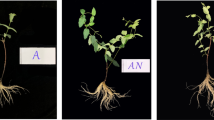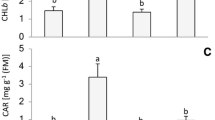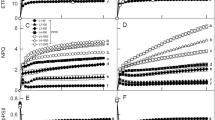Abstract
Main conclusion
Components of the photosynthetic electron transport chain in pea (Pisum sativum L.) leaves under in vivo conditions showed the following sensitivity to the inhibitory action of chromium(VI): intersystem electron transport > photosystem I > photosystem II.
Abstract
Inhibitory effects of chromium (VI) (K2Cr2O7, Cr) on the light reactions of photosynthesis were studied in vivo in Pisum sativum L. by using Multi-function Plant Efficiency Analyser (M-PEA-2). Photosynthetic parameters related to photosystem (PS) II, PSI and intersystem electron carriers were calculated from the light-induced kinetics of prompt chlorophyll a fluorescence (OJIP transient), delayed chlorophyll a fluorescence (DF), and 820 nm modulated reflection (MR). We showed that the I2 step of DF induction is sensitive to inhibition of the Q0 site of the cytochrome b6f complex. Such parameters as δRo of the JIP test related to the functional state of photosynthetic reactions beyond the PQ pool, Vred of the MR induction assigned to the overall rate of P700+ and plastocyanin reduction, and I2 step of the DF induction were significantly altered in the presence of low-dose Cr(VI). Moderate doses of Cr affected mainly PSI-related parameters including Vox and ΔMR parameters of the MR induction, whereas high-dose treatment influenced JIP test parameters φPo(= FV/FM) and ψEo related to PSII. The obtained results showed that the earliest Cr(VI) effect on the photosynthetic electron transport chain manifests itself by inhibition of the intersystem electron transport, rather, at the level of the cytochrome b6f complex. Inhibitory effects of Cr on PSI were more pronounced than those on PSII. Sensitivity of the used kinetic parameters toward the functional state of photosynthetic reactions makes this approach suitable for early diagnostics of toxic action of pollutants on plants.






Similar content being viewed by others
Abbreviations
- Chl:
-
Chlorophyll
- PS:
-
Photosystem
- PQ:
-
Plastoquinone
- QA and QB :
-
Primary and secondary electron acceptors in PSII
- PET:
-
Photosynthetic electron transport
- O, J, I, P:
-
Particular steps in the Chl fluorescence induction curve
- DF:
-
Delayed Chl fluorescence
- MR:
-
820 nm modulated reflection, M-PEA: Multi-function Plant Efficiency Analyser
- M-PEA:
-
Multi-function Plant Efficiency Analyser
- HM:
-
Heavy metal
- Cr:
-
Chromium
- PPFD:
-
Photosynthetic photon flux density
References
Ali NA, Dewez D, Didur O, Popovic R (2006) Inhibition of photosystem II photochemistry by Cr is caused by the alteration of both D1 protein and oxygen evolving complex. Photosynth Res 89:81–87. https://doi.org/10.1007/s11120-006-9085-5
Antal TK, Kovalenko IB, Rubin AB, Tyystjärvi E (2013) Photosynthesis-related quantities for education and modeling. Photosynth Res 117:1–30. https://doi.org/10.1007/s11120-013-9945-8
Antal T, Maslakov A, Yakovleva O, Krendeleva T, Riznichenko G, Rubin A (2018) Simulation of chlorophyll fluorescence rise and decay kinetics, and P700—related absorbance changes by using a rule-based kinetic Monte-Carlo method. Photosynth Res 138:191–206. https://doi.org/10.1007/s11120-018-0564-2
Antal T, Konyukhov I, Volgusheva A, Plyusnina T, Khruschev S, Kukarskikh G, Goryachev S, Rubin A (2019) Chlorophyll fluorescence induction and relaxation system for the continuous monitoring of photosynthetic capacity in photobioreactiors. Physiol Plantarum 165:476–486. https://doi.org/10.1111/ppl.12693
Appenroth KJ, Stӧckel A, Srivastava A, Strasser RJ (2001) Multiple effects of chromate on the photosynthetic apparatus of Spirodela polyrhiza as probed by OJIP chlorophyll a fluorescence measurements. Environ Pollut 115:49–64. https://doi.org/10.1016/S0269-7491(01)00091-4
Beyersmann D, Hartwig A (2008) Carcinogenic metal compounds: recent insight into molecular and cellular mechanisms. Arch Toxicol 82:493–512. https://doi.org/10.1007/s00204-008-0313-y
Bishnoi NR, Chugh K, Sawhney SK (1993) Effect of chromium on photosynthesis, respiration and nitrogen fixation in pea (Pisum sativum L.) seedlings. J Plant Physiol 142:25–30. https://doi.org/10.1016/S0176-1617(11)80102-1
Ceppi MG, Oukarroum A, Çiçek N, Strasser RJ, Schansker G (2012) The IP amplitude of the fluorescence rise OJIP is sensitive to changes in the photosystem I content of leaves: a study on plants exposed to magnesium and sulfate deficiencies, drought stress and salt stress. Physiol Plant 144(3):277–288. https://doi.org/10.1111/j.1399-3054.2011.01549.x
Chain RK, Malkin R (1979) On the interaction of 2,5-dibromo-3-methyl-6-isopropylbenzoquinone (DBMIB) with bound electron carriers in spinach chloroplasts. Arch Biochem Biophys 197:52–56. https://doi.org/10.1016/0003-9861(79)90217-0
Clijsters H, Van Assche F (1985) Inhibition of photosynthesis by heavy metals. Photosynth Res 7:31–40
Dąbrowski P, Baczewska-Dąbrowska AH, Kalaji HM, Goltsev V, Paunov M, Rapacz M, Wójcik-Jagła M, Pawluśkiewicz B, Bąba W, Brestic M (2019) Exploration of chlorophyll a fluorescence and plant gas exchange parameters as indicators of drought tolerance in perennial ryegrass. Sensors (Basel) 19(12):E2736. https://doi.org/10.3390/s19122736
Dhir Bhupinder, Sharmila P, Pardha-Saradhi P (2008) Photosynthetic performance of Salvinia natans exposed to chromium and zinc rich wastewater. Braz J Plant Physiol 20:61–70. https://doi.org/10.1590/S1677-04202008000100007
Didur O, Dewez D, Popovic R (2013) Alteration of chromium effect on photosystem II activity in Chlamydomonas reinhardtii cultures under different synchronized state of the cell cycle. Environ Sci Pollut Res 20:1870–1875. https://doi.org/10.1007/s11356-012-1389-8
Diwan H, Ahmad A, Iqbal M (2012) Chromium-induced alterations in photosynthesis and associated attributes in Indian mustard. J Environ Biol 33:239–244
Evans EH, Crofts AR (1973) The relationship between delayed fluorescence and the H+ gradient in chloroplasts. Biochim Biophys Acta 292:130–139. https://doi.org/10.1016/0005-2728(73)90257-0
Goltsev V, Chernev P, Zaharieva I, Lambrev P, Strasser RJ (2005) Kinetics of delayed chlorophyll a fluorescence registered in milliseconds time range. Photosynth Res 84:209–215. https://doi.org/10.1007/s11120-004-6432-2
Goltsev V, Chernev P, Zaharieva I, Strasser RJ (2009) Delayed fluorescence in photosynthesis. Photosynth Res 101:217–232. https://doi.org/10.1007/s11120-009-9451-1
Gomes MA, Hauser-Davis RA, Suzuki MS, Vitória AP (2017) Plant chromium uptake and transport, physiological effects and recent advances in molecular investigations. Ecotoxicol Environ Saf 140:55–64. https://doi.org/10.1016/j.ecoenv.2017.01.042
Govindjee (2004) Chlorophyll a fluorescence: a bit of basics and history. In: Papageorgiou GC, Govindjee (eds) Chlorophyll fluorescence: a signature of photosynthesis. Springer, Dordrecht, pp 1–42. https://doi.org/10.1007/978-1-4020-3218-9
Hayat S, Khalique G, Irfan M, Wani AS, Tripathi BN, Ahmad A (2012) Physiological changes induced by chromium stress in plants: an overview. Protoplasma 249:599–611. https://doi.org/10.1007/s00709-011-0331-0
Hörcsik ZT, Kovács L, Láposi R, Mészáros I, Lakatos G, Garab G (2007) Effect of chromium on photosystem 2 in the unicellular green alga, Chlorella pyrenoidosa. Photosynthetica 45:65–69. https://doi.org/10.1007/s11099-007-0010-8
Jursinic P, Wraight CA, Govindjee (1978) Membrane potential and microsecond to millisecond delayed light emission after a single excitation flash in isolated chloroplasts. Photochem Photobiol 27:61–71. https://doi.org/10.1111/j.1751-1097.1978.tb07566.x
Kalaji HM, Goltsev VN, Żuk-Gołaszewska K, Zivcak M, Brestic M (2017) Chlorophyll fluorescence: understanding crop performance—basics and applications. CRC Press, Boca Raton. https://doi.org/10.1201/9781315153605
Kalaji HM, Rastogi A, Živčák M, Brestic M, Daszkowska-Golec A, Sitko K, Alsharafa KY, Lotfi R, Stypiński P, Samborska IA, Cetner MD (2018) Prompt chlorophyll fluorescence as a tool for crop phenotyping: an example of barley landraces exposed to various abiotic stress factors. Photosynthetica 56:953–961. https://doi.org/10.1007/s11099-018-0766-z
Krupa Z, Baszynski T (1995) Some aspects of heavy metal toxicity towards photosynthetic apparatus-direct and indirect effects on light and dark reactions. Acta Physiol Plant 17:177–190
Liu D, Zou J, Wang M, Jiang W (2008) Hexavalent chromium uptake and its effects on mineral uptake, antioxidant defence system and photosynthesis in Amaranthus viridis L. Bioresour Technol 99:2628–2636. https://doi.org/10.1016/j.biortech.2007.04.045
Maslakov AS, Antal TK, Riznichenko GYu, Rubin AB (2016) Modeling of primary photosynthetic processes using the kinetic Monte Carlo method. Biophysics 61(3):387–399. https://doi.org/10.1134/S000635091603009X
Mathur S, Kalaji HM, Jajoo A (2016) Investigation of deleterious effects of chromium phytotoxicity and photosynthesis in wheat plant. Photosynthetica 54:185–192. https://doi.org/10.1007/s11099-016-0198-6
Murchie EH, Lawson T (2013) Chlorophyll fluorescence analysis: a guide to good practice and understanding some new applications. J Exp Botany 64:3983–3998. https://doi.org/10.1093/jxb/ert208
Oláh V, Lakatos G, Bertók C, Kanalas P, Szollosi E, Kis J, Mészáros I (2010) Short-term chromium(VI) stress induces different photosynthetic responses in two duckweed species, Lemna gibba L. and Lemna minor L. Photosynthetica 48:513–520. https://doi.org/10.1007/s11099-010-0068-6
Oukarroum A, Goltsev V, Strasser RJ (2013) Temperature effects on pea plants probed by simultaneous measurements of the kinetics of prompt fluorescence, delayed fluorescence and modulated 820 nm reflection. PLoS One 8:1–10. https://doi.org/10.1371/journal.pone.0059433
Pan X, Chen X, Zhang D, Wang J, Deng C, Mu G, Zhu H (2009) Effect of chromium(VI) on photosystem II activity and heterogeneity of Synechocystis sp. (Cyanophyta): studied with in vivo chlorophyll fluorescence tests. J Phycol 45:3861–3894. https://doi.org/10.1111/j.1529-8817.2009.00647.x
Panda SK, Choudhury S (2005) Chromium stress in plants. Braz J Plant Physiol 17:95–102. https://doi.org/10.1590/S1677-04202005000100008
Pandey V, Dikshit V, Shyam R (2013) Hexavalent chromium induced inhibition of photosynthetic electron transport in isolated spinach chloroplasts. In: Zvy Dubinsky (ed) Photosynthesis. IntechOpen. https://doi.org/10.5772/55143
Porcar-Castell A, Pfündel E, Korhonen JF, Juurola E (2008) A new monitoring PAM fluorometer (MONI-PAM) to study the short- and long-term acclimation of photosystem II in field conditions. Photosynth Res 96:173–179. https://doi.org/10.1007/s11120-008-9292-3
Prasad MNV, Strzalka K (1999) Impact of heavy metals on photosynthesis. In: Prasad MNV, Hagemeyer J (eds) Heavy metal stress in plants. Springer, Berlin, pp 117–138. https://doi.org/10.1007/978-3-662-07745-0_6
Rai V, Vajpayee P, Singh SN, Mehrotra S (2004) Effect of chromium accumulation on photosynthetic pigments, oxidative stress defense system, nitrate reduction, proline level and eugenol content of Ocimum tenuiflorum L. Plant Sci 167:1159–1169. https://doi.org/10.1016/j.plantsci.2004.06.016
Rao BK, Tyryshkin AM, Roberts AG, Bowman MK, Kramer DM (2000) Inhibitory copper binding site on the spinach cytochrome b6f complex: implications for Qo site catalysis. Biochem 39:3285–3296. https://doi.org/10.1021/bi991974a
Reski R, Abel WO (1985) Induction of budding on chloronemata and caulonemata of the moss, Physcomitrella patens, using isopentenyladenine. Planta 165:354–358. https://doi.org/10.1007/BF00392232
Roberts AG, Bowman MK, Kramer DM (2002) Certain metal ions are inhibitors of cytochrome b6f complex ‘Rieske’ iron–sulfur protein domain movements. Biochem 41:4070–4079. https://doi.org/10.1021/bi015996k
Rodriguez E, Santos C, Azevedo R, Moutinho-Pereira J, Correia C, Dias MC (2012) Chromium (VI) induces toxicity at different photosynthetic levels in pea. Plant Physiol Biochem 53:94–100. https://doi.org/10.1016/j.plaphy.2012.01.013
Schansker G, Srivastava A, Govindjee, Strasser RJ (2003) Characterization of the 820-nm transmission signal paralleling the chlorophyll a fluorescence rise (OJIP) in pea leaves. Funct Plant Biol 30:785–796. https://doi.org/10.1071/FP03032
Schansker G, Tóth SZ, Strasser RJ (2005) Methylviologen and dibromothymoquinone treatments of pea leaves reveal the role of photosystem I in the Chl a fluorescence rise OJIP. Biochim Biophys Acta 1706:250–261. https://doi.org/10.1016/j.bbabio.2004.11.006
Shahid MB, Shamshad S, Rafiq M, Khalid S, Bibi I, Niazi NK, Dumat C, Rashid MI (2017) Chromium speciation, bioavailability, uptake, toxicity and detoxification in soil-plant system: a review. Chemosphere 178:513–533. https://doi.org/10.1016/j.chemosphere.2017.03.074
Shanker AK, Cervantes C, Loza-Tavera H, Avudainayagam S (2005) Chromium toxicity in plants. Environ Int 31:739–753. https://doi.org/10.1016/j.envint.2005.02.003
Sheoran IS, Singh R (1993) Effect of heavy metals on photosynthesis in higher plants. In: Abrol YP et al (eds) Photosynthesis: photoreactions to plant productivity. Springer Science and Business Media, Dordrecht, pp 451–468. https://doi.org/10.1007/978-94-011-2708-0_18
Singh HP, Mahajan P, Kaur S, Batish DR, Kohli RK (2013) Chromium toxicity and tolerance in plants. Environ Chem Lett 11:229–254. https://doi.org/10.1007/s10311-013-0407-5
Stirbet A, Govindjee (2011) On the relation between the Kautsky effect (chlorophyll a fluorescence induction) and photosystem II: basics and applications of the OJIP fluorescence transient. J Photochem Photobiol 104:236–257. https://doi.org/10.1016/j.jphotobiol.2010.12.010
Stirbet A, Govindjee (2012) Chlorophyll a fluorescence induction: a personal perspective of the thermal phase, the J-I-P rise. Photosynth Res 113:15–61. https://doi.org/10.1007/s11120-012-9754-5
Stirbet A, Riznichenko GY, Rubin AB, Govindjee (2014) Modeling chlorophyll a fluorescence transient: relation to photosynthesis. Biochemistry (Mosc) 79(4):291–323. https://doi.org/10.1134/S0006297914040014
Stirbet A, Lazár D, Kromdijk J, Govindjee (2018) Chlorophyll a fluorescence induction: can just a one-second measurement be used to quantify abiotic stress responses? Photosynthetica 56:86–104. https://doi.org/10.1007/s11099-018-0770-3
Strasser RJ, Govindjee (1992) On the O-J–I–P fluorescence transients in leaves and D1 mutants of Chlamydomonas reinhardtii. In: Murata N (ed) Research in photosynthesis, vol 2. Kluwer Academic, Dordrecht, pp 29–32
Strasser BJ, Strasser RJ (1995) Measuring fast fluorescence transients to address environmental questions: the JIP-test. In: Mathis P (ed) Photosynthesis: from light to biosphere. KAP Press, Dordrecht, pp 977–980. https://doi.org/10.1007/978-94-009-0173-5_1142
Strasser RJ, Srivastava A, Govindjee X (1995) Polyphasic chlorophyll a fluorescence transients in plants and cyanobacteria. Photochem Photobiol 61:32–42. https://doi.org/10.1111/j.1751-1097.1995.tb09240.x
Strasser RJ, Tsimilli-Michael M, Strivastava A (2004) Analysis of the chlorophyll a fluorescence transient. In: Papageorgiou GC, Govindjee (eds) Chlorophyll fluorescence: a signature of photosynthesis, vol 19. Springer, Dordrecht, pp 679–703. https://doi.org/10.1007/978-1-4020-3218-9_12
Strasser RJ, Tsimilli-Michael M, Qiang S, Goltsev V (2010) Simultaneous in vivo recording of prompt and delayed fluorescence and 820-nm reflection changes during drying and after rehydration of the resurrection plant Haberlea rhodopensis. Biochim Biophys Acta 1797:1313–1326. https://doi.org/10.1016/j.bbabio.2010.03.008
Subrahmanyam D (2008) Effects of chromium toxicity on leaf photosynthetic characteristics and oxidative changes in wheat (Triticum aestivum L.). Photosynthetica 46:339–345. https://doi.org/10.1007/s11099-008-0062-4
Susplugas S, Srivastava A, Strasser RJ (2000) Changes in the photosynthetic activities during several stages of vegetative growth of Spirodela polyrhiza: effect of chromate. J Plant Physiol 157:503–512. https://doi.org/10.1016/S0176-1617(00)80105-4
Tsimilli-Michael M, Strasser RJ (2008) In vivo assessment of plants’ vitality: applications in detecting and evaluating the impact of mycorrhization on host plants. In: Varma A (ed) Mycorrhiza: state of the art. Genetics and molecular biology, eco-function, biotechnology, eco-physiology, structure and systematics, 3rd edn. Springer, Dordrecht, pp 679–703. https://doi.org/10.1007/978-3-540-78826-3_32
Tyystjarvi E, Vass I (2004) Light emission as a probe of charge separation and recombination in the photosynthetic apparatus: relation of prompt fluorescence to delayed light emission and thermoluminescence. In: Papageorgiou G (ed) Chlorophyll a fluorescence: a signature of photosynthesis. Springer, Dordrecht, pp 363–388. https://doi.org/10.1007/978-1-4020-3218-9_13
Vajpayee P, Tripathi RD, Rai UN, Ali MB, Singh SN (2000) Chromium (VI) accumulation reduces chlorophyll biosynthesis, nitrate reductase activity and protein content in Nymphaea alba L. Chemosphere 41:1075–1082. https://doi.org/10.1016/S0045-6535(99)00426-9
Van Assche F, Clijsters H (1983) Multiple effects of heavy metals on photosynthesis. In: Marcelle R (ed) Effects of stress on photosynthesis. Nijhoff/W Junk, The Hague, pp 371–382
Xin C-P, Yang J, Zhu X-G (2013) A model of chlorophyll a fluorescence induction kinetics with explicit description of structural constraints of individual photosystem II units. Photosynth Res 117:339–354. https://doi.org/10.1007/s11120-013-9894-2
Zaharieva I, Taneva SG, Goltsev V (1999) Effect of PSII antennae size on the induction kinetics of prompt and delayed chlorophyll fluorescence. Bulg J Plant Physiol 25:17–30
Zaharieva I, Taneva SG, Goltsev V (2001) Effect of temperature on the luminescent characteristics in leaves of Arabidopsis mutants with decreased unsaturation of the membrane lipids. Bulg J Plant Physiol 27:3–18
Acknowledgements
The authors thank Dr. N. Seifullina for growing plants, A. Maslakov for assistance with modeling, and Dr. E. Tyystjarvi for help with manuscript preparation. The authors acknowledge the support from the Russian Foundation for Basic Research (projects 17-04-00676 and 19-04-00999).
Author information
Authors and Affiliations
Corresponding author
Ethics declarations
Conflict of interest
The authors declare that they have no conflict of interest.
Additional information
Publisher's Note
Springer Nature remains neutral with regard to jurisdictional claims in published maps and institutional affiliations.
Rights and permissions
About this article
Cite this article
Todorenko, D., Timofeev, N., Kovalenko, I. et al. Chromium effects on photosynthetic electron transport in pea (Pisum sativum L.). Planta 251, 11 (2020). https://doi.org/10.1007/s00425-019-03304-1
Received:
Accepted:
Published:
DOI: https://doi.org/10.1007/s00425-019-03304-1




